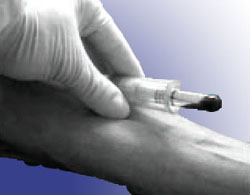 |
|
|
�The Prostrate
Check |
|
�
The
first step in any medical checkup is a
thorough medical history, including a family
history. Your doctor will ask you questions
about any past problems, treatments, or
medical procedures and about any symptoms
you are having, particularly problems with
urination.
Early diagnosis of
prostate cancer increases the chance of a
cure.
�
|
|
Examination
A physical examination is the second step.
The prostate is an internal organ, so the
physician cannot look at it directly.
However, the doctor can feel the prostate by
inserting a gloved, lubricated finger into
the rectum. This simple procedure is called
a digital rectal examination (DRE). This
necessary examination allows the physician
to estimate whether the prostate is enlarged
or has lumps or areas of abnormal texture.
While this examination may produce momentary
discomfort, it causes neither damage nor
severe pain. If the results of the digital
rectal examination suggest that you may have
a significant prostate problem, your doctor
may refer you to a urologist. This is a
doctor who specializes in diseases of the
urinary tract and male reproductive system.
The urologist may perform additional tests,
including blood tests, urine tests, and/ or
other diagnostic procedures, to determine
the nature of your prostate problem.
Prostate cancer also may
spread (metastasize) to other parts of the
body, such as the lymph nodes, the lungs,
and the bones, especially the bones of the
hip and lower back.
|
.. |
When examining the prostate,
your physician inserts his/her
forefinger (wearing a lubricated
glove) and presses gently on the
lower wall of the rectum. |
|
| � |
|
The PSA Blood
Test The PSA
test detects the level of prostate specific
antigen in the blood. PSA is a protein
originally found in semen, the fluid that
carries sperm. Normally, PSA is made in the
epithelial cells of the prostate, which
produce some of the semen that comes out of
the penis at the time of sexual climax
(orgasm). PSA is only made by prostate
cells. Small amounts of the protein get into
the circulatory system and can be measured
in the blood. Certain prostate conditions,
including cancer, can cause high levels of
PSA in the blood. Once a small blood sample
is taken, the level of PSA is measured by an
accurate laboratory method called an
immunoassay. Many factors can cause the PSA
to rise, but PSA itself is harmless. The PSA
blood test is used, along with the DRE, to
find men who may need further testing. PSA
cannot diagnose prostate cancer, however,
only a biopsy can do that. The PSA test also
is used to track the progress of men being
treated for prostate cancer. If treatment is
effective, the PSA should remain in the
normal range. Improved methods of PSA
testing are being developed. In the future,
these may help your urologist decide whether
the rise in PSA is due to prostate cancer or
to a less serious problem. |
|
 |
|
� |
| � |
|
Florida Prostate Cancer Network is a
Florida non-profit organization
Federal Tax ID 59-3545266
|
|
|
|
Disclaimer
|
-
"The information that FPCN
provides is general and
informative.�
FPCN's information should not
take the place of the advice
from your doctor."
�
-
Site maintained by:
www.e-logosetc.com
|
|
|
|
|
